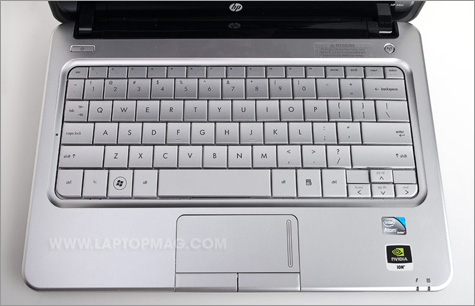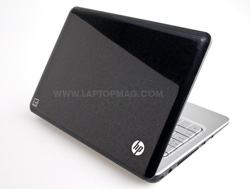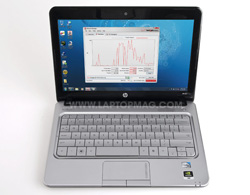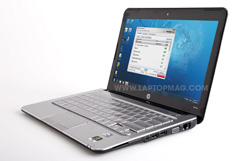Laptop Mag Verdict
Nvidia Ion graphics and built-in 3G wireless make this netbook a good value.
Pros
- +
Very good graphics performance
- +
Built-in mobile broadband
- +
Stylish design
- +
Comfortable keyboard
- +
Loud speakers
Cons
- -
Shorter battery life than Windows XP version
- -
Touchpad has too much friction
Why you can trust Laptop Mag
Editor's Note: Portions of this review were taken from our earlier review of the HP Mini 311.
Up until now, we've been hesitant to recommend 3G netbooks sold through wireless carriers or retailers. We like the convenience of built-in mobile broadband, but $59.99 per month is a lot pay for connectivity on a secondary PC. The HP Mini 311 is different. This 11.6-inch netbook ($199 through Verizon Wireless with a two-year contract and $100 online discount) not only has a bigger screen than other subsidized models, but it features Nvidia Ion graphics, providing plenty of muscle for Windows 7 Premium. Ion also gives you the ability to enjoy high-definition video and mainstream games, and you can even edit movies at a pretty fast clip. This version of the Mini 311 has shorter battery life than its XP cousin, but if you want a slick ultraportable that lets you connect anywhere, it's a good choice.
Design
The Mini 311 combines elements from several of HP's larger notebooks: its black lid (also available in white) bears HP's Swirl pattern. A black speaker grille unobtrusively lines the front edge of the chassis, and the silver deck, keyboard, and touchpad remind us of the company's Pavilion Series.
Measuring 11.4 x 8.0 x 1.3 inches, the Mini 311 is roughly the same size as the Acer Aspire 1410 and the MSI Wind U210. We were glad to see that HP's battery is integrated with the chassis, and doesn't jut out the back. With a weight of 3.2 pounds, this machine is easy to carry.
Keyboard and Touchpad
The Mini 311's square silver keys practically abut each other, and are slightly indented to provide a resting place for your fingers. Typing on the keys was comfortable, and we were up to our normal speed almost immediately. Despite the keys' smooth surface, our fingers did not slip.
Sign up to receive The Snapshot, a free special dispatch from Laptop Mag, in your inbox.
Click to enlarge
Below, the silver touchpad is amply sized for an 11-inch netbook. At 3.3 x 1.5 inches, it's almost the same size as that on the Toshiba mini NB205. Unlike the NB205, however, the 311's touchpad has some friction, an issue we've had with other HP notebooks. In other words, navigating the desktop isn't as smooth as it could be. The two mouse buttons are decently sized, but we found them to be slightly stiff to press toward the outer edges.
Display and Audio
The 11.6-inch display on the Mini 311 has a resolution of 1366 x 768, which makes it easier to view Web pages and documents without having to scroll. The glossy display has excellent horizontal viewing angles; we could see the screen clearly from nearly 90 degrees to either side, though tilting the screen forward resulted in a rather quick image reversal.
Along the front edge of the notebook is a black speaker grille that hides Altec Lansing stereo speakers, which provide better sound than we're used to from netbooks. While listening to Oasis' "Live Forever," sound was on the tinny side, but we heard much more bass than is typical of systems this size. Still, we could hear the Mini 311 from a few feet away without straining.
Ports and Webcam
Click to enlarge
Click to enlarge
There are no surprises when it comes to the port selection on the Mini 311. On the left side is a USB 2.0 and HDMI port; on the right is Ethernet, VGA, two USB 2.0, headphone/mic, and a 5-in-1 memory card reader.
Performance
Click to enlarge
The Mini 311 uses a 1.6-GHz Intel Atom N270 processor--typical of just about every netbook--but has 2GB of RAM, whereas the XP version of the Mini 311 only had 1GB. Where the 311 really differs from the netbook field is in the grahics: Instead of an integrated Intel chipset, the Mini 311 has an Nvidia Ion LE GPU. While not as powerful as the entry-level Nvidia graphics chips seen on larger systems, the Ion LE still provides a measure of performance far and above all other netbooks.
On PCMark Vantage, which measures overall system performance, the Mini 311 scored 1,227, which is 120 points above the current netbook average. (As of this writing, however, we have tested relatively few netbooks running Windows 7.) On the other hand, it's worth noting that this score is approximately half that of the Acer Aspire 1410, which uses an Intel Celeron processor.
Needless to say, we were able to perform everyday tasks easily; we simultaneously had several tabs open in Internet Explorer, wrote this review in Microsoft Works, and downloaded games from the Steam service without a hitch.
Still, when it comes to CPU-intensive tasks, the Mini 311 is pretty much like any other netbook. In Geekbench, the Mini 311 scored 861, which, while 27 points higher than average, was beat by the Gateway LT3103u (902) and Toshiba mini NB205-N210 (920), and was about 30 points lower than the Mini 311 running XP. When watching an episode of Community and The Simpsons streamed through Hulu (a Flash-based player that does not yet take advantage of the GPU), video was choppy, and not in sync with audio. This should improve with the advent of Flash 10.1, which will be graphics accelerated.
The 5,400-rpm, 160GB hard drive performed adequately, duplicating a 4.97GB folder of multimedia files at a rate of 17.2 MBps, which is a bit above average, and 1.6 MBps faster than the XP version of the Mini 311. The system's boot time of 60 seconds was a marked improvement over the 1:44 it took the earlier Mini 311; for netbooks, 56 seconds is the average.
Graphics Performance
The Mini 311 produced an impressive score in 3DMark06 (which measures graphics performance): 1,450. That's 1,320 points above the netbook average, and an increase of 64 over the XP Mini 311. The only netbook to beat this score was the ASUS N10Jc (in Speed Mode), and that machine has switchable Nvidia graphics. The only other system that comes close--the AMD-powered Gateway LT3103u--is over 1,190 points away.
Compared to ultraportable notebooks with Intel's integrated graphics, the Mini 311's 3DMark06 score trounces the Intel GMA 4500MHD graphics inside the $699 MSI X340 (643) and the Intel GMA X4500MHD graphics inside the $799 ASUS UL30A (760). In fact, the Mini 311's score is 574 points better than the overall ultraportable average, and almost identical to the latest MacBook Air (1,385).
HD Video Playback, Video Editing
Click to enlarge
We output a 1080p MPEG-4 trailer (Cloudy with a Chance of Meatballs) via HDMI from the system to a 32-inch Samsung HDTV. The Ion-powered netbook held up well, delivering satisfactory detail and great color. We saw only a few instances of motion blur, but the clip took 30 seconds to cue up. On the other hand, when we played the same clip on a Dell Mini Inspiron 10 (with an HDMI port), the action stuttered so much that it looked little better than a slideshow.
Another area where Ion is supposed to shine is video editing. The typical netbook takes about half an hour to transcode a 114MB file from AVI to MPEG-4 using HandBrake. Using only the Share feature in vReveal, a program that can tap into Ion's graphics muscle to speed up transcode times, the HP Mini 311 converted the same file in 4 minutes and 52 seconds--an improvement of almost a minute and a half over the XP 311, and almost six times as fast as the average netbook. The average ultraportable takes 13:14; in this case, Ion is more than twice as fast. Of course, when we ran the transcoding test on the Mini 311 using HandBrake--a program that doesn't leverage the GPU for transcoding--the system finished in a much more pedestrian 30:30.
Gaming Performance
So Ion vastly improves graphics performance and provides a boost to the system overall. But can an Ion netbook handle gaming? We ran the Far Cry 2 benchmark on the Mini 311, something we generally don't even bother with on other netbooks. With the resolution set to 1024 x 768, the machine averaged 10 frames per second. That's 2 fps above the ultraportable average, and well above the ULV dual-core ASUS UL30A and Acer Aspire Timeline 3810T (5 and 3 fps, respectively). It should be noted, though, that in order to get this frame rate, the effects had to be set to low; with eye candy turned up and at its native resolution of 1366 x 768, the Mini 311 mustered just 6 fps.
Ion provides better performance in mainstream games. We were impressed with how the Mini 311 was able to handle World of Warcraft. With the resolution set to 1366 x 768, we were able to fly from Orgrimmar to Thunder Hills with a frame rate of 32 fps. However, when we upped the effects to ultra, the framerate dropped to 14 fps.
Heat
While playing games and watching videos, the Mini 311 stayed relatively cool; the area between the G and H keys and the touchpad never exceeded 90 degrees Fahrenheit; the underside topped off at around 100 degrees, but never seemed uncomfortable on our lap.
3G Wireless
Click to enlarge
The reason you would buy the Mini 311 through Verizon Wireless is its built-in mobile broadband. Using the included VZAccess Manager software, you can get online in about 10 seconds using the carrier's nationwide 3G network for a very good surfing experience on the go. From our office in midtown Manhattan, we saw a download speed between 1.2 and 1.3 Mbps and an upload speed between 500 and 600 Kbps using Speedtest.net. That's better throughput than what the Nokia Booklet 3G (which uses AT&T's network) provided.
NYTimes.com took a brisk 11 seconds to completely load; ESPN.com (which is more multimedia-heavy) took 16 seconds; and Laptopmag.com took 11 seconds.
If you opt for the 5GB data plan, you'll pay $59.99 per month. Verizon Wireless also offers a $39.99 plan for 250MB, but we don't recommend it for two reasons. First, 250MB is not a lot of data. After 45 minutes of surfing the Web (including just 5 minutes of video streaming) we used over 40MB. That means if we used 3G on the Mini 311 for only 45 minutes a day, we would reach Verizon's 250MB cap in less than a week. Second, if you go over this limit, you'll get charged 10 cents for each additional megabyte. (The 5GB has a lower overage charge of 5 cents per MB.)
Wi-Fi and Battery Life
The Mini 311's 802.11/b/g/n Wi-Fi card showed outstanding throughput of 33.2 Mbps at 15 feet from our access point; that's 13.2 Mbps above the netbook average. More impressively, connectivity strength remained high (20.3 Mbps) at 50 feet; that's 3.8 Mbps above average at that distance.
Battery life was the one area where the Mini 311 left us a bit disappointed. The six-cell lithium ion battery lasted 4 hours and 52 minutes on our LAPTOP Battery Test (Web surfing via Wi-Fi); that's decent endurance, but this runtime is about 50 minutes less than the XP version of the Mini 311, and 89 minutes shy of the six-cell netbook average. With the 3G radio engaged, battery life diminished to 3:45. The Nokia Booklet 3G, by comparison, saw 8:13 when surfing the Web using its 3G connection, and the Gateway LT2016u got 4:41. Still, both of those systems have lower-powered Intel graphics.
Configurations
While only one model of the Mini 311 is available through Verizon Wireless, HP now offers a number of different ways in which you can configure the Mini 311 through its site.
If you configured the Mini 311 identically to the model sold through Verizon--without 3G--it would cost $524. Customers can select hard drives increasing in size to 250GB ($30), 320GB (60), or an 80GB SSD ($210). You can also choose the slightly faster 1.66-GHz Intel Atom N280 for an additional $25, as well as an additional 1GB of RAM for $30. Of course, you're still bound by Microsoft's rules governing Windows XP. If you opt for that operating system ($50 less than Windows 7), you can only select 1GB of RAM and a 160GB hard drive. An external 8X DVD drive can be had for $50, and an external Blu-ray drive can be purchased for $130.
Green Testing
Click to enlarge
It took 2 hours to recharge the Mini 311's battery, consuming 5820.1 watts in the process. When this is divided by its battery life (to determine its LAPTOP Battery Efficiency Rating; lower is better), the Mini 311 scored 19.9. That's just above the netbook average of 16.6.
Software and Warranty
The HP Mini 311 comes with a 60-day trial of Norton Internet Security and Microsoft Works. The system is backed with a one-year limited hardware warranty with 24/7 toll-free phone support. To see how HP fared in our annual Tech Support Showdown, click here.
Verdict
With the HP Mini 311, Verizon Wireless is selling the first 3G netbook that performs like a notebook. Nvidia's powerful graphics give travelers the ability to do more than consume media; they can now create it. Depending on your needs, this machine could be powerful enough to be your primary PC. We wish the touchpad were smoother and that the system lasted longer on a charge, but overall the Mini 311 is the best subsidized netbook yet for those who want broadband connectivity on the go.
HP Mini 311 (Verizon Wireless) Specs
| Bluetooth | Bluetooth 2.1 |
| Brand | HP |
| CPU | 1.6-GHz Intel Atom N270 |
| Card Slots | 5-1 card reader |
| Company Website | http://www.hp.com |
| Display Size | 11.6 |
| Graphics Card | Nvidia Ion LE |
| Hard Drive Size | 160GB |
| Hard Drive Speed | 5,400rpm |
| Mobile Broadband | Verizon EV-DO Rev A |
| Native Resolution | 1366x768 |
| Operating System | MS Windows 7 Home Premium |
| Ports (excluding USB) | VGA, Headphone/Mic, HDMI, Ethernet |
| RAM | 2GB |
| RAM Upgradable to | 3GB |
| Size | 11.4 x 8.0 x 1.3 inches |
| USB Ports | 3 |
| Video Memory | 895MB |
| Warranty/Support | One-year limited/24/7 toll-free phone |
| Weight | 3.2 pounds |
| Wi-Fi | 802.11b/g/n |
Michael was the Reviews Editor at Laptop Mag. During his tenure at Laptop Mag, Michael reviewed some of the best laptops at the time, including notebooks from brands like Acer, Apple, Dell, Lenovo, and Asus. He wrote in-depth, hands-on guides about laptops that defined the world of tech, but he also stepped outside of the laptop world to talk about phones and wearables. He is now the U.S. Editor-in-Chief at our sister site Tom's Guide, where he oversees all evergreen content and the Homes, Smart Home, and Fitness/Wearables categories for the site..







